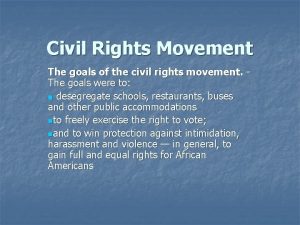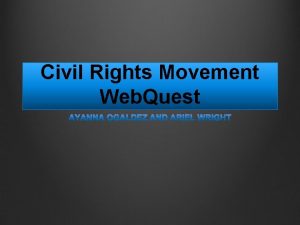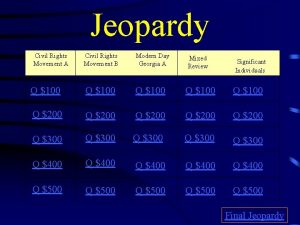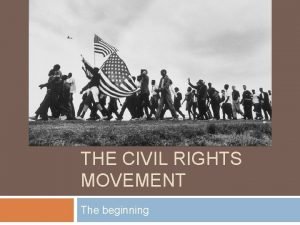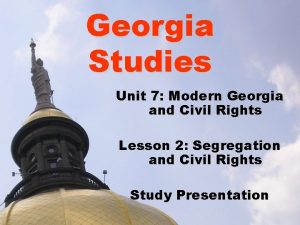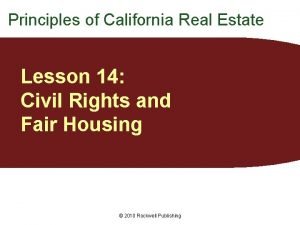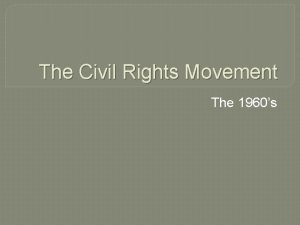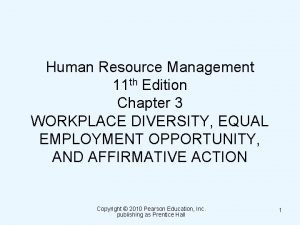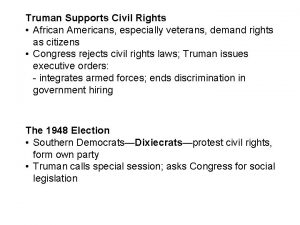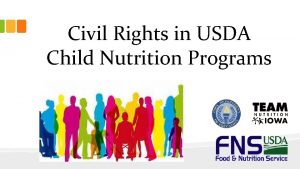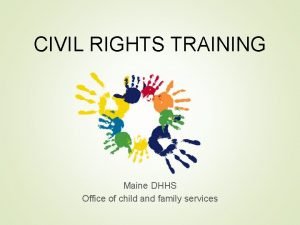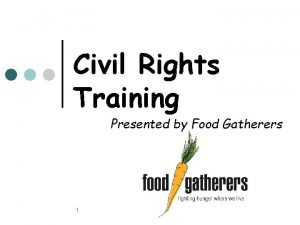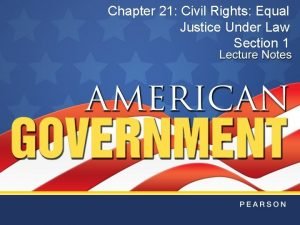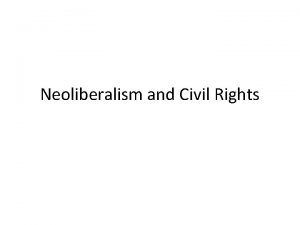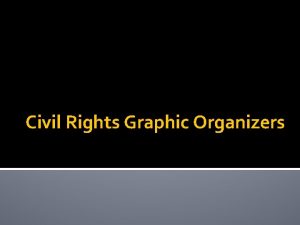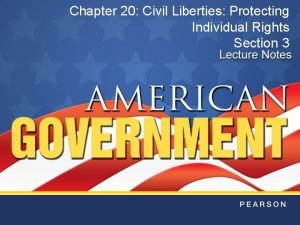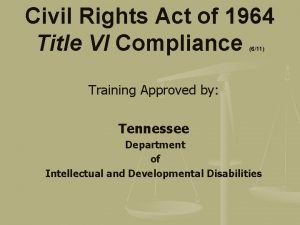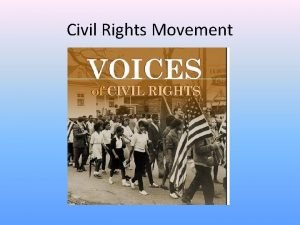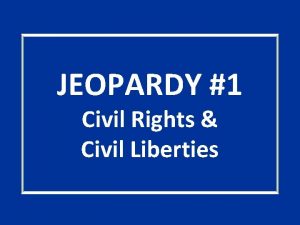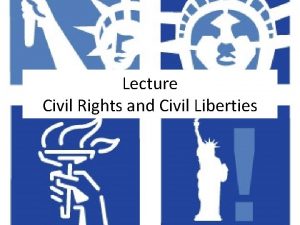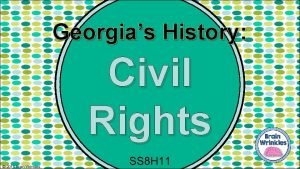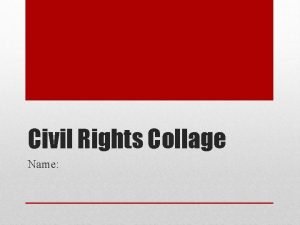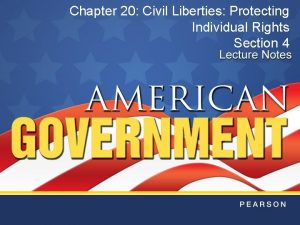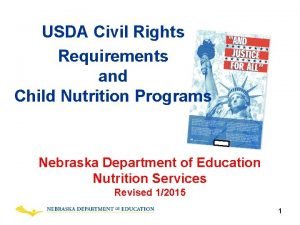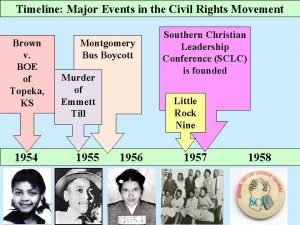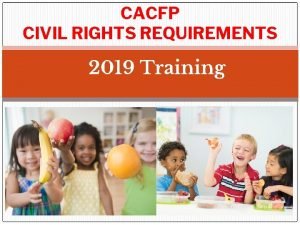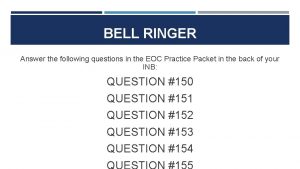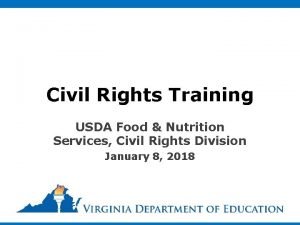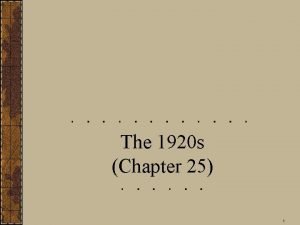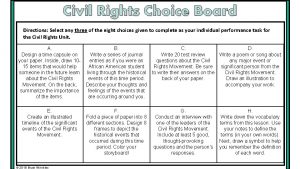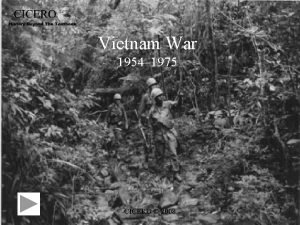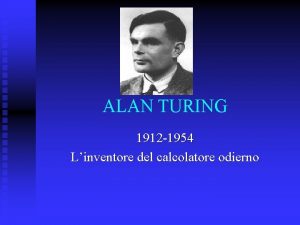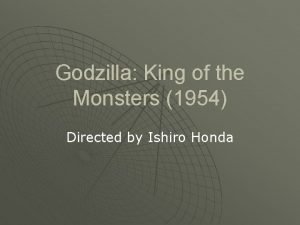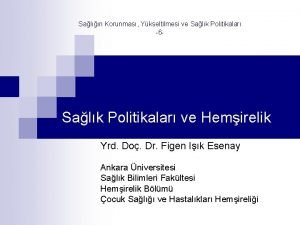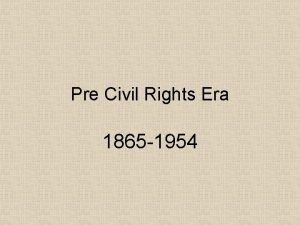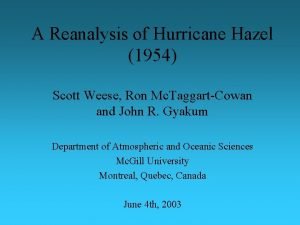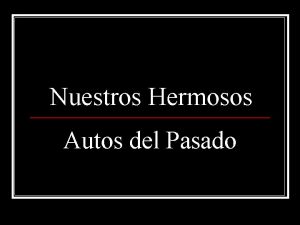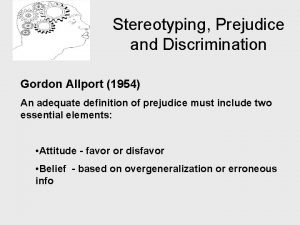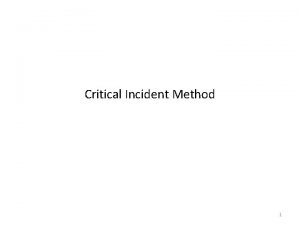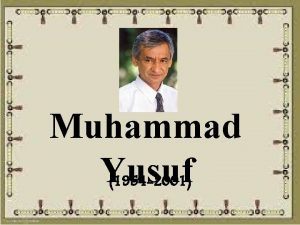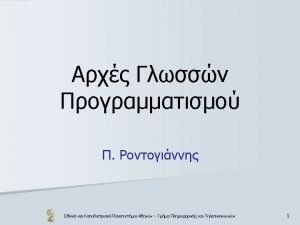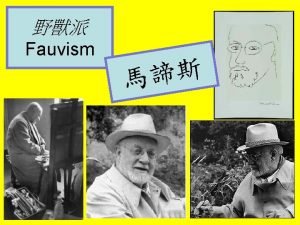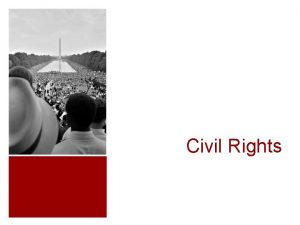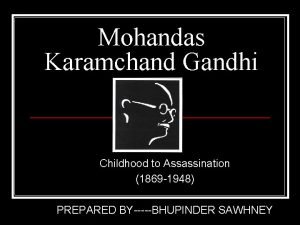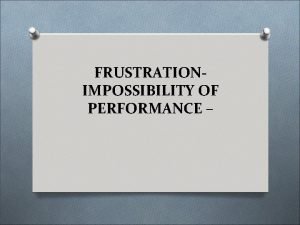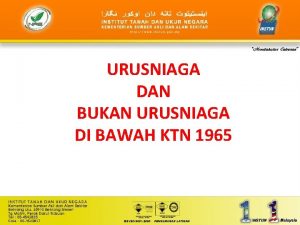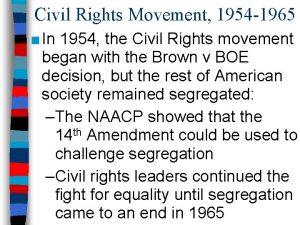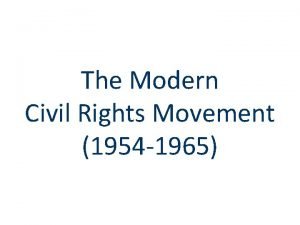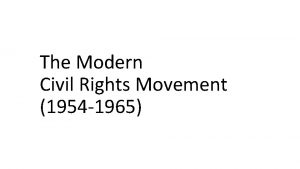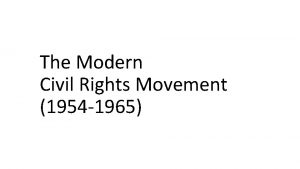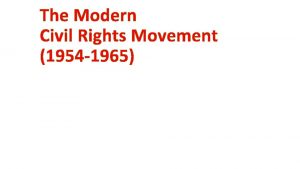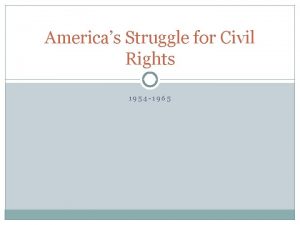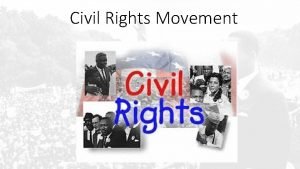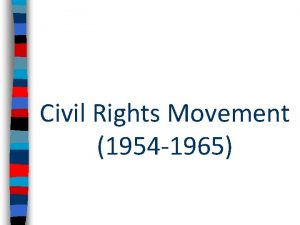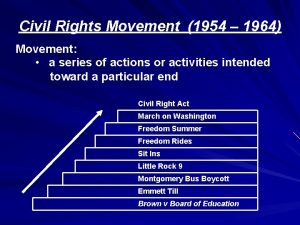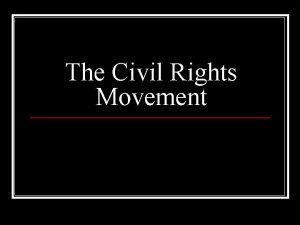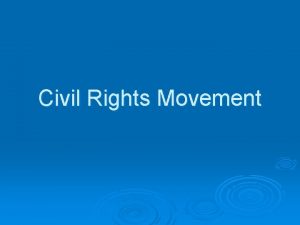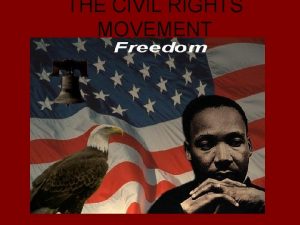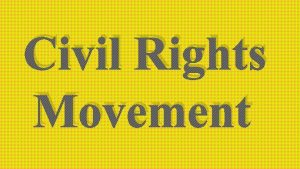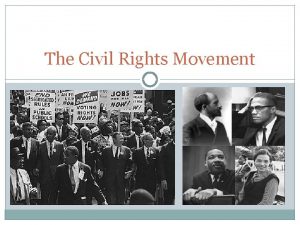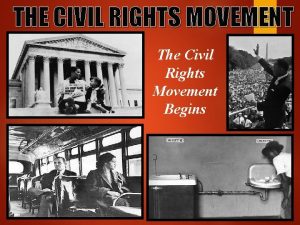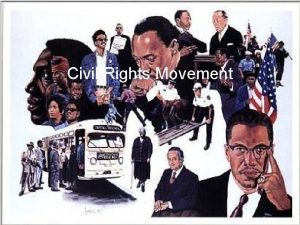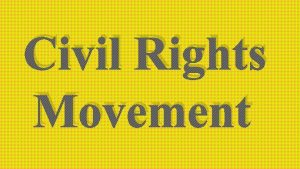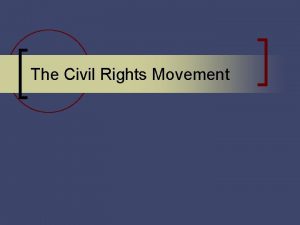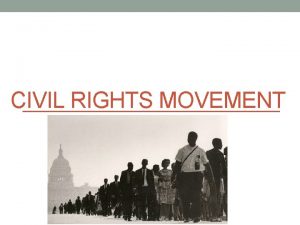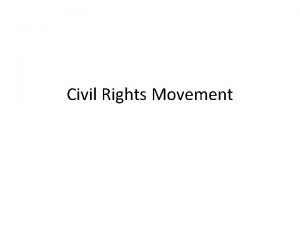The Modern Civil Rights Movement 1954 1965 The









































































- Slides: 73

The Modern Civil Rights Movement (1954 -1965)

The Beginnings of Black Activism ■ Instead of waiting for the government to help, blacks pressed the issue ■ NAACP had fought segregation since 1909 ■ Congress of Racial Equality was organized in 1942 – Used sit-ins to desegregate restaurants ■ Soldiers returning home from WWII had expected appreciation. – Determined to change things led to the Civil Rights Movement

The Struggle Over Civil Rights ■ The modern Civil Rights movement began in 1954 with Brown v BOE & ended with the Voting Rights Act of 1965 – Blacks in the West & North had lowpaying jobs & faced segregated neighborhoods – The Deep South was a totally segregated society due to Jim Crow laws

■ Schools became the primary target of early civil rights advocates in the 1950 s – The NAACP 1 st targeted unfair university graduate admissions – Thurgood Marshall, a NAACP lawyer, used the 14 th Amendment to attack school segregation & Plessy v Ferguson precedent

Even “equal” schools, if separate, inflict profound psychological damage to black children

Desegregating the Schools ■ The Supreme Court’s unanimous decision in Brown v Board of Education (1954) Education ruled “separate facilities are inherently unequal” – Called for desegregation at “deliberate speed” by states – Border states complied quickly but the Deep South resisted—by 1960 less than 1% of blacks attended school with whites

Thurgood Marshall’s success in Brown made him the most famous black lawyer in America; In 1967, LBJ made him the 1 st black justice to the Supreme Court

Desegregating the Schools ■ Eisenhower’s silence on Brown sent a false message that he supported segregation – In 1957, Arkansas Governor called the National Guard to prevent blacks to enter Central High

■ TV coverage brought national attention ■ Ike sent in the army to force integration for the “Little Rock 9” ■ 1000 soldiers remained at the school for a year

Integrating Central High School in Little Rock, Arkansas (1957) Governor Orval Faubus

Montgomery Bus Boycott ■ Dec. 1, 1955 ■ Began after the Rosa Parks arrest – Effective carpool system forced buses to stop segregation – Supreme Court ruled AL bus segregation unconstitutional – This success led to the rise of Martin Luther King as a civil rights leader

Montgomery Bus Boycott ■ https: //www. biography. com/video/ montgomery-bus-boycott 109142595821

Montgomery Bus Boycott (1955) ■ Rosa Parks arrest ■ Carpool system

Southern Christian Leadership Conference ■ Formed to directly attack segregation – MLK’s passionate oration inspired blacks to support cause – Peaceful resistance & appeal to Christian love were the basis of these resistance efforts

■ “If cursed, do not curse back. If struck, do not strike back, but evidence love and goodwill at all times” ■ “We will match your capacity to endure suffering. We will meet your physical force with soul force. We will not hate you, but we will not obey your evil laws. We will wear you down by pure capacity to suffer. ”

Sit-In at Woolworth’s ■ In 1960, 4 students from North Carolina Agricultural and Technical State University led a sit-in at a segregated lunch counter in Greensboro, NC: – Inspired similar sit-ins, wade-ins, & kneel -ins across the South – Led to the Student Nonviolent Coordinating Committee ■ SCLC & SNCC soon surpassed the NAACP for leadership of the civil rights movement


Greensboro Sit-in Tougaloo Sit-in


Not only were there sit-ins. . . ■ Swim-ins (beaches, pools) ■ Kneel-ins (churches) ■ Drive-ins (at motels) ■ Study-ins (universities)

Moving Slowly on Civil Rights ■ John F. Kennedy campaigned for civil rights, but his fear of alienating southern Democrats forced a retreat: – JFK deferred to Congress & sent his brother, Attorney General Robert F. Kennedy, to help blacks in the South

■ The Justice Dept helped with voting rights lawsuits, but the FBI could not protect civil rights activists in the South ■ ■ Civil Rights leaders refused to wait for JFK and the government to respond

Freedom Ride ■ Congress of Racial Equality led a freedom ride in 1961 to protest segregated buses – To draw attention to the South’s refusal to obey federal laws – In Anniston, AL – bus firebombed – In Birmingham, AL – riders were beaten with bats, chains, and lead pipes ■ Nation is shocked

Freedom Rides, 1961


– In Jackson, MS, JFK struck a deal with Mississippi Senator, James Eastland, to allow the riders to be arrested as long as they did not face any violence. • He was meeting with Soviet Leader Khrushchev and did not want anything to disrupt the meeting

• Once he returned from the Soviet Union, JFK ordered the Interstate Commerce Commission to tighten regulations. • Robert Kennedy ordered the Justice Department to take legal actions against cities allowing segregation in bus terminals • By 1962, interstate travel segregation had ended

School Integration ■ Activists attempted to break a ban on black enrollment at Ole Miss & University of Alabama ■ Mississippi Governor, Ross Barnett, stood in the way of James Meredith attempting to enter the University of Mississippi. ■ Kennedy dispatched 500 troops to escort Meredith ■ Was under protection for the remainder of the year.


– When African American students attempted to desegregate the University of Alabama in June 1963, the new governor, George Wallace, flanked by state troopers, literally blocked the door of the enrollment office

– JFK federalized National Guard troops and deployed them to the University of Alabama to force its desegregation – Two African American students–Vivian Malone and James A. Hood successfully enrolled


th 16 Street Bombing ■ On Sunday morning in 1963, the KKK bombed the Sixteenth Street Baptist Church in Birmingham, Alabama, killing four girls. ■ This shocked the nation and electrified the civil rights movement.

Birmingham Marches, 1963 ■ MLK forced JFK to openly support the plight of African-Americans in 1963, via the Birmingham march – Police commissioner “Bull” Connor used brutal force to end the protests & MLK was jailed – Police brutality helped sway public sentiment & allowed JFK to begin civil rights legislation



■ MLK’s Letter From Birmingham Jail (1963) articulated the non-violent protest of the civil rights movement

"I Have a Dream" ■ In 1963, CORE, SCLC, NAACP, & SNCC organized a March on Washington to pressure the government to pass a civil rights act ■ 200, 000 civil rights protesters heard MLK give the “I Have a Dream” speech for racial equality ■ The Kennedy Administration responded by laying framework for a Civil Rights Act


Civil Rights under LBJ ■ Lyndon Johnson made civil rights the major component of his presidency: – In 1964, the 24 th Amendment was ratified banning poll taxes – The Civil Rights Act of 1964 declared Civil Rights Act of 1964 segregation in public facilities illegal & officially ended the majority of Jim Crow laws

Civil Rights Act of 1964 ■ 1963 - supported by President Kennedy; after his assassination, President Johnson called for its passage as a tribute to JFK ■ Outlawed segregation in businesses, banned discriminatory practices in employment on the basis of race, color, religion, sex and national origin, and ended segregation in public places

Civil Rights under LBJ ■ Civil rights groups were not content & continued for equality: – Freedom Summer in 1964 led to the registration of thousands of Mississippi blacks to vote

■ The 1965 protest march from Selma, Alabama to Montgomery led to police violence; “Bloody Sunday” shocked people in the North more than any other event

Voter Registration ■ CORE volunteers came to Mississippi to register Blacks to vote.

These volunteers risked arrest, violence and death every day.

1964 – Freedom Summer ■ 1000’s of college students went to Mississippi to help with voter registration and participate in sit ins and marches.

The Fight ■ This man spent 5 days in jail for “carrying a placard. ” ■ Sign says “Voter registration worker”

White victims of violence ■ This Rabbi was beaten with a tire iron for registering voters


Voter Registration ■ If blacks registered to vote, the local banks could call the loan on their farm.

Selma, Alabama (1965)

Civil Rights under LBJ ■ After the Selma march, LBJ & Congress passed the Voting Rights Act (1965) – Banned literacy tests & sent federal voting officials into the South to protect voters – The act finally accomplished what Radical Republicans had envisioned when the 15 th Amendment was enacted in 1870

Voting Rights Act of 1965 ■ Prohibits the use of voting laws, practices or procedures, such as poll taxes, literacy tests, intimidation…that discriminate in either purpose or effect on the basis of race, color, or membership in a minority language group

Black became Voter a. Registration South Blacks voting force inin. Southern politics for the 1 st time since Reconstruction

Civil Rights Groups ■ National Association for the Advancement of Colored People (NAACP) - achieved victories and supported court cases to provide equal protection under the law and end segregation

■ Congress of Racial Equality (CORE) – used sit-ins to try and desegregate public facilities ■ Southern Christian Leadership Conference (SCLC) – attempted to eliminate segregation and encourage African Americans to register to vote

Martin Luther King, Jr. ■ Baptist minister, social activist, and orator ■ Inspired and led blacks and whites to end segregation and racism through nonviolent resistance, such as the Montgomery Bus Boycott, March on Washington… ■ MLK March on Washington -"I have a dream" ■ 1964 – won the Nobel Peace Prize ■ Willing to be a martyr for the cause whether it meant prison or death ■ 1968 – Assassinated by James Earl Ray

MLK’s last speech ■ I would like to live a long life. Longevity has its place. But I'm not concerned about that now. I just want to do God's will. And He's allowed me to go up to the mountain. And I've looked over. And I've seen the promised land. I may not get there with you.

Left to right: Hosea Williams, Jesse Jackson, Martin Luther King Jr. , Rev. Ralph David Abernathy on the balcony of the Lorraine Motel Memphis hotel, a day before King's assassination. April 3, 1968

Malcolm X A black militant, who symbolized black power, defense of African American rights and improvement of their conditions even if it meant violence ■ Criminal background; while in prison, joined the Nation of Islam who stressed black nationalism but taught that white people were “devils. ” ■ Broke from the Black Muslims and traveled to Mecca, Saudi Arabia, and Africa ■ Because of his trip to Mecca, changed his philosophy hoping one day all races will be joined in brotherhood ■ 1965 -Assassinated by three members of the Nation of Islam who did not agree with his new philosophy

"I believe in the brotherhood of man, all men, but I don't believe in brotherhood with anybody who doesn't want brotherhood with me. I believe in treating people right, but I'm not going to waste my time trying to treat somebody right who doesn't know how to return the treatment. " -- Malcolm X, 1964

Black Panthers ■ Influenced by Malcolm X ■ Believed a revolution was necessary in the United States to gain equality ■ Adopted a “Ten-Point Program” that called for black empowerment, an end to racial oppression, and control of major institutions and services in the African American Community ■ Openly carried weapons in public and were prepared to use violence

Martin Luther King, Jr. v. Malcolm X MLK, Jr. ■ Raised in a middle class ■ family ■ Earned a Ph. D. from Boston University ■ ■ Advocated nonviolent ■ direct action ■ ■ Called for integration; whites supported and financed the movement ■ African Americans felt ■ his protests were not assertive enough Malcolm X Emerged from the black underclass in northern ghettos Dropped out of school Advocated self defense Wanted Blacks to love themselves and unite to control their communities Black Muslims accused him of seeking personal glory

Civil Rights legal achievements ■ President Harry Truman ordered the armed forces and the government to be desegregated in 1948.

John F. Kennedy ■ Called Coretta Scott King to pledge support while MLK was in jail. ■ Eventually sent federal protection of freedom riders ■ Proposed need for civil rights legislation

Lyndon B. Johnson passed ■ Civil Rights Act of ’ 64 ■ Civil Rights Act of ’ 68 ■ Voting Rights Act of ’ 65 ■ 24 th Amendment banning poll taxes

RIOTS ■ Days after the Voting Rights Act of 1965, race riot broke out in Watts, an African American neighborhood in South Central Los Angeles. ■ It lasted 6 days, cost $40 million, killed 34, injured over 1, 000, required over 14, 000 California National Guard troops and set a curfew zone over 45 miles to restore public order – Spurred from the arrest of Marquette Frye for suspicion of driving while intoxicated. Tensions between police officers and the crowd erupted in a violent exchange


■ The Detroit Race Riot in the summer of 1967 was one of the most violent urban revolts in the 20 th century. – Officers raided an after hours an unlicensed bar in the center of the city’s oldest and poorest black neighborhood. A party celebrating the return of two black servicemen from Vietnam was in progress. Officers arrested all 82 people attending the party. – A crowd gathered

– In the five days and nights of violence 33 blacks and 10 whites were killed, 1, 189 were injured and over 7, 200 people were arrested. – Approximately 2, 500 stores were looted and the total property damage was estimated at about $32 million. – 800 State Police Officers and 8, 000 National Guardsmen were ordered to the city and were later augmented by 4, 700 paratroopers from the 82 nd Airborne Division ordered in by President Lyndon Johnson


■ Until the riots following the death of Dr. King in April 1968, the Detroit Race Riot stood as the largest urban uprising of the 1960 s.

 Rosa parks mother
Rosa parks mother Civil rights and civil liberties webquest
Civil rights and civil liberties webquest Goals of the civil rights movement
Goals of the civil rights movement Civil rights movement essential questions
Civil rights movement essential questions Civil rights movement vocabulary
Civil rights movement vocabulary Civil rights movement webquest
Civil rights movement webquest Civil rights movement jeopardy
Civil rights movement jeopardy The civil rights movement
The civil rights movement Unit 7 modern ga and civil rights
Unit 7 modern ga and civil rights Unruh civil rights act real estate
Unruh civil rights act real estate Civil rights sitins
Civil rights sitins Title vii of the civil rights act
Title vii of the civil rights act Truman supports civil rights
Truman supports civil rights Civil rights in child nutrition programs
Civil rights in child nutrition programs Civil rights training child nutrition programs
Civil rights training child nutrition programs What did sncc accomplish and how
What did sncc accomplish and how Federally protected classes
Federally protected classes Chapter 21 civil rights equal justice under law
Chapter 21 civil rights equal justice under law Kerner commission apush
Kerner commission apush Title vii of the civil rights act
Title vii of the civil rights act Characteristics of civil rights
Characteristics of civil rights Civil rights graphic organizer
Civil rights graphic organizer Chapter 20 civil liberties protecting individual rights
Chapter 20 civil liberties protecting individual rights Title vi of the civil rights act of 1964
Title vi of the civil rights act of 1964 Civil rights movment
Civil rights movment Chapter 20 civil liberties protecting individual rights
Chapter 20 civil liberties protecting individual rights Civil rights jeopardy
Civil rights jeopardy Right to die
Right to die Civil rights cloze notes 1
Civil rights cloze notes 1 Civil rights collage
Civil rights collage Chapter 20 civil liberties protecting individual rights
Chapter 20 civil liberties protecting individual rights Civil rights in child nutrition programs
Civil rights in child nutrition programs Civil rights timeline of events
Civil rights timeline of events Cacfp civil rights
Cacfp civil rights Civil rights bell ringers
Civil rights bell ringers Usda civil rights training
Usda civil rights training Chapter 14 postwar prosperity and civil rights
Chapter 14 postwar prosperity and civil rights Civil rights cloze notes
Civil rights cloze notes Civil rights choice board
Civil rights choice board Frida kahlo 1907 a 1954
Frida kahlo 1907 a 1954 1975-1954
1975-1954 1954
1954 Godzilla king of the monsters 1954
Godzilla king of the monsters 1954 Color 15111999
Color 15111999 Başhemşire nasıl olunur
Başhemşire nasıl olunur Ron hubbard 1954
Ron hubbard 1954 1954-1865
1954-1865 Hurricane morgan 1954
Hurricane morgan 1954 Fortran 1954
Fortran 1954 Why is it coincidental that ruby was born in 1954?
Why is it coincidental that ruby was born in 1954? 1954 chevrolet bel air
1954 chevrolet bel air Magnétoscope 1954
Magnétoscope 1954 Point o woods old lyme
Point o woods old lyme Allport 1954
Allport 1954 Flanagan 1954
Flanagan 1954 Muhammad yusuf sherlari maylida
Muhammad yusuf sherlari maylida Ibm formula 1
Ibm formula 1 Lydia delectorskaya
Lydia delectorskaya Negative right
Negative right Legal rights and moral rights
Legal rights and moral rights Positive vs negative rights
Positive vs negative rights Positive vs negative rights
Positive vs negative rights Legal rights vs moral rights
Legal rights vs moral rights Positive rights and negative rights
Positive rights and negative rights Littoral rights real estate
Littoral rights real estate Negative rights
Negative rights Civil right movement def
Civil right movement def Program of civil disobedience movement
Program of civil disobedience movement Civil war first modern war
Civil war first modern war Berney v tronoh mines
Berney v tronoh mines Ktn 1965
Ktn 1965 External debt of the philippines since 1965
External debt of the philippines since 1965 Nutella weetjes
Nutella weetjes Timeline european literature
Timeline european literature


